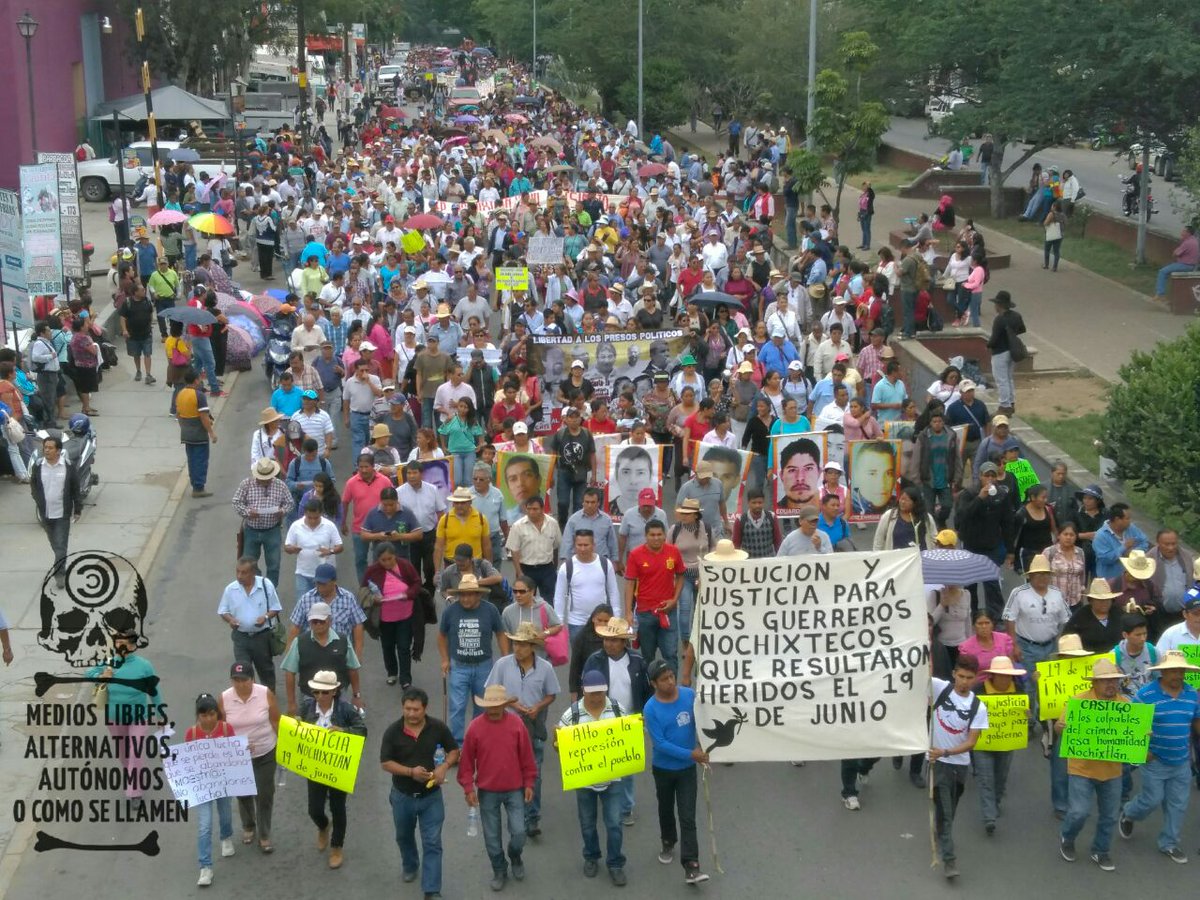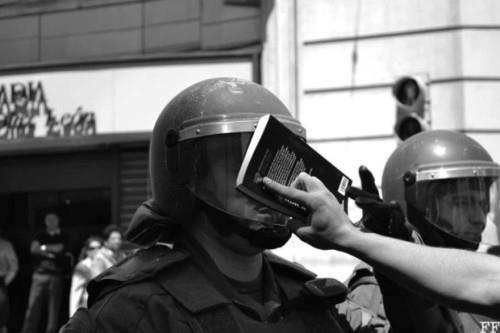Filed under: Editorials, Insumisión, Mexico

Originally posted on It’s Going Down
By Scott Campbell
As the strike against educational reform by teachers belonging to the National Coordinator of Education Workers (CNTE) in Mexico enters its fourth month, the conflict between the people and the neoliberal narcostate seems poised to take another turn, a potentially violent one. The government is running out of tricks, leaving the likelihood it will return to its old standby, state violence, all the more likely.
When the strike first began on May 15, the government’s tactic was to ignore the teachers, refusing to talk to them. As that failed and support for the teachers grew, it tried brute force, leading to the Nochixtlán massacre on June 19, a day when twelve were killed. That repression caused national outrage and succeeded in turning a teachers’ movement into a popular one. The government then offered up negotiations as a fig leaf, yet meeting after meeting made clear that the state had no actual interest in negotiating anything. The school year started in Mexico on Monday, August 22, but teachers remain on strike and schools have not opened in Oaxaca, Chiapas, Guerrero, Michoacán and parts of Mexico City.
Frustrated in their attempts to crush or wear down the teachers, Mexican President Enrique Peña Nieto announced on upon the start of classes that, “There will be no more dialogue; education first.” A day later on August 23, Public Education Minister Aurelio Nuño stated, “With complete clarity we say, there is no possibility of returning to any negotiations until all children are where they should be, in a classroom. And precisely because the future of Mexico is non-negotiable, the Educational Reform will continue.” The Defense Minister got into the act, claiming the armed forces support the reform and that soldiers want “to serve as an example for others.” Not coincidentally, that same day three airplanes full of federal police arrived in Oaxaca to join the thousands of state forces already stationed there, an indication that Peña Nieto may make good on his statement that “the government has no qualms about applying the use of force” as a means to resolve the teachers’ strike. At least 1,500 more federal police were in Oaxaca by Wednesday, August 24 and helicopter flyovers of the city had resumed for the first time since the Nochixtlán massacre.
In recent weeks, mass mobilizations and movement organizing efforts have continued. August 8, Emiliano Zapata’s birthday, saw upwards of 100,000 teachers and farmers march together in Mexico City. A day later, farmers, teachers and civil society groups took over a toll plaza on the Nayarit-Sinaloa highway, allowing cars to pass for free and asking that instead of paying the toll drivers donate to the struggle. Teachers, civil society groups and prominent academics gathered in Mexico City on August 10 for a twelve-hour national forum to discuss what a democratic and holistic education project would look like. A second forum will happen in September. During this time, for five days in a row teachers in Chiapas blockaded and shut down businesses belonging to transnational corporations and companies who are part of the neoliberal business association Mexicanos Primeros. Another business group, COPARMEX, recently lamented that the teachers’ strike has caused more economic damage than the armed Zapatista uprising in 1994. On August 12, Secretary General Rubén Núñez and Organization Secretary Francisco Villalobos of CNTE Section 22 in Oaxaca were released from prison. And the Guatemalan teachers union also expressed their support, shutting down an international crossing with Mexico for the second time on August 13.
Following the last round of fruitless talks with the government on August 16, the CNTE agreed on August 18 to not return to classes. They were backed up in Chiapas by parents assemblies that vowed to shut down any school that attempted to open on August 22. Instead, the school year was kicked off in the rebellious south with tens of thousands marching in Chiapas and Oaxaca and the installation of 25 highway blockades for 48 hours in Oaxaca alone.
Peña Nieto is likely seeking to impose a solution to the strike before long. September 15 is Mexico’s Independence Day and an increase in state repression often occurs right beforehand to ensure the reign of social peace for an undisturbed celebration of nationalism. Just down the road, the PRI will be retaking power in Oaxaca under the governorship of Alejandro Murat on December 1, and positioning is already underway for the 2018 presidential elections, with none other than Public Education Minister Aurelio Nuño pushing to be the PRI candidate.
One last note about the teachers. Section 22 in Oaxaca previously set up a fund for the survivors and families of the victims of the Nochixtlán massacre. The Mexican government, in collaboration with Santander Bank, quickly shut it down, confiscating the 17,000 pesos it contained. There is again a way to donate to the Nochixtlán fund. For obvious reasons, it is not public. If you or your crew would like to donate/organize a benefit, get in touch at scott [at] fallingintoincandescence [dot] com.
Aside from the teachers’ strike, Peña Nieto has been having a rough couple of weeks in the realm of popular opinion. On August 11, a poll revealed his approval rating to be at a historically low 23 percent. This certainly wasn’t helped when five days later The Guardian reported that Peña Nieto’s wife, Angelica Rivera, has been enjoying stays in Key Biscayne, Florida at a $2 million apartment owned by Grupo Pierdant, a company bidding on Mexican government contracts. This news broke only a month after Peña Nieto apologized for the “perception” of wrong-doing related to Rivera’s $7 million purchase of a home in Guerrero owned by government contractor Grupo Higa. Then on August 21, a widely publicized exposé showed that Peña Nieto plagiarized nearly one-third of his university thesis. While these PR stumbles certainly don’t cast Peña Nieto in a positive light, he still maintains the support of the elite and these incidents pale in comparison to the broader devastation and exploitation he has wrought on Mexico.
Challenges to the status quo continue outside of the teachers’ strike as well. On August 11, students from Michoacán’s eight teaching colleges (normales) burned two trucks on train tracks and blockaded a highway. The students were acting in support of the teachers and also demanding the government guarantee a certain number of jobs upon graduation. Currently the state government refuses to hire teachers coming from normales in Michoacán. At a subsequent protest on August 15, while the normalistas were blockading a highway, federal and state police arrived and opened fire on them. Forty-one were arrested and fortunately no one was killed. Eight students remain in maximum security prison.
On that same day, to the east in the State of Mexico, police opened fire on students protesting cuts in enrollment at an extension school of the National Autonomous University of Mexico (UNAM) in Naucalpan. The shooting is the first example of the use of the Eruviel Law, which allows police in the State of Mexico to fire live ammunition at demonstrations and punishes police who don’t follow orders to do so.
https://youtu.be/jMAe8lWTenw
Atenco, also in the State of Mexico, received a solidarity visit from environmentalists Vandana Shiva and Sebastiao Pinheiro on August 13 in support of the community’s struggle against the latest attempt to build Mexico City’s new international airport on its lands. Construction of the highway to leading to the airport was ordered suspended on July 26, yet crews and machinery began operating again on August 16. Atencans ran the crews off their land and reinforced the encampment in Tocuila, designed to impede construction. On August 18 and 19, construction began again, escorted by a “shock group” of men hired by a local authority. The group tore down and burned the encampment on August 19 and threw stones at Atencans who came out to defend their land. Defiant as ever, Atenco residents rebuilt the encampment the same day.
#Alerta Máxima #GrupoDeChoque ataca a ejidatarios #Atenco periodistas y organizaciones solidarias https://t.co/bLrtNIDzgo@CNDH @kehuelga
— Yaotl (@yaocitlaltzin) August 19, 2016
The state of Morelos, south of Mexico City, saw a massive demonstration of 100,000 on August 16, when teachers, civil society groups and even the Autonomous University of the State of Morelos (UAEM) called for a mobilization against Governor Graco Ramírez. Protesters were demanding he be removed from office and charged for the ongoing femicides, kidnappings, murders, and corruption. Students also erected an encampment surrounding the state government’s offices. As if to make the point clearer, a report released a week later found that of the 117 bodies illegally buried in mass graves by the state prosecutor’s office in Morelos, 84 showed signs of torture. Naturally, the state’s reply was to issue an arrest warrant for the president of UAEM. In a similar case, Professor Rene Torres in Mexico City has been arrested three times in three days, only to be released without charge each time, in clear retaliation for his support of the student struggle at the National Polytechnic Institute (IPN).
A few more pieces to share to round out this latest dispatch of news. The relatives of the disappeared students from Ayotzinapa have cut off negotiations with the federal government. They say they will not return until Tomás Zerón, the head of the Criminal Investigation Agency (equivalent to the FBI in the US), is removed from his position. To mark 23 months since the disappearance, the families will be holding a cultural, artistic and political event outside of Aztec Stadium on August 26. Environmental defender and political prisoner Ildefenso Zamora was freed after nearly nine months in prison on trumped-up charges on August 13. A report on Radio Zapote documents the ongoing struggle of farmworkers in San Quintín and their primary tool: a boycott of Driscoll’s Berries. While actions are frequent in the US, a Boycott Driscoll’s protest occurred at a supermarket in Mexico City on August 18. On August 22 and 23 the first National Gathering on Forced Disappearance was held in Mexico City.
Apoyemos a jornaler@s #SanQuintín:
Hagamos crecer el #BoycottDriscolls
Así la protesta en Superama Coyoacán, CDMX pic.twitter.com/SHIPU9Q8yk
— Compa Liliana (@Loe_25sept) August 19, 2016
After months of organizing, 105 indigenous Oxchuc communities jointly decided to expel political parties and elected officials from their lands and to return to governing according to the indigenous practice of usos y costumbres. The final event of the Zapatista-initiated CompArte Festival for Humanity occurred in the Zapatista caracol of Roberto Barrios. Here’s a translation of Subcomandante Moisés’ statement at the end of the festival. The National Indigenous Congress, a Zapatista-inspired formation, will celebrate 20 years of existence with its fifth gathering in San Cristóbal, Chiapas in October. In other indigenous-related news, a new report noted that 80 percent of Mexico’s indigenous population lives in “poverty”. A condition that, if you’re Governor Mario López of Sinaloa, exists because of laziness. In response to a report that 822,000 Sinaloans live in “extreme poverty”, López said, “In Sinaloa, if you’re hungry, it’s because you’re lazy.”
Anarchist political prisoner Fernando Bárcenas released a call for solidarity with the prison strike happening in US prisons on September 9. We’ll have the English translation up shortly. And a group of anarchists offered a difficult but important public reflection on the events surrounding the police murder of anarchist Salvador Olmos in Oaxaca in June, which It’s Going Down has published in English.








